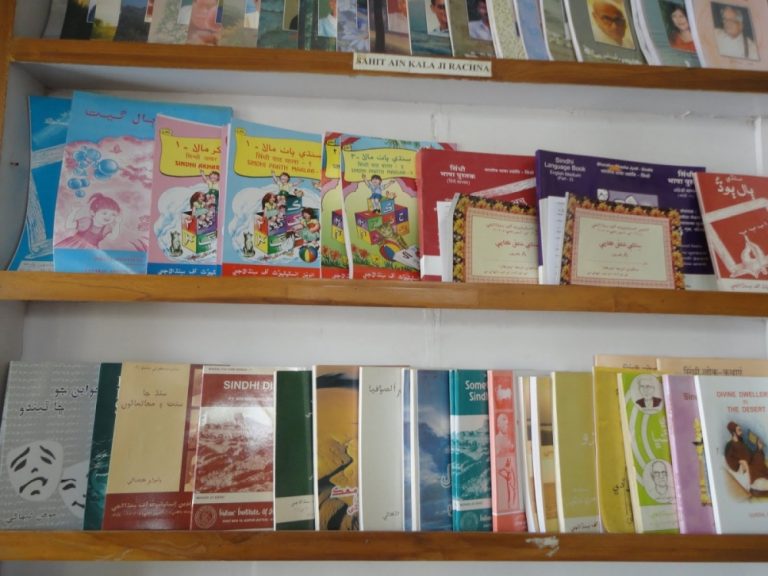
[Culturopedia is an Encyclopedia of India’s Art and Culture, its Heritage and Customs & Traditions. According to this encyclopedia, there are more than one thousand languages in India and several thousand dialects. These include 418 listed languages, of which 407 are living languages and eleven are extinct. There are twenty two languages mentioned in the Eighth Schedule of the Constitution as ‘National’ languages of India without legal standing. Hindi in the Devanagari script is the official language of the Union of India while each state and union territory has adopted its own regional language as the official language. English is the second official language of the country besides being the administrative, legislative and judicial language. English is also the official language of the states of Nagaland and Meghalaya.
Sindhi is one of the twenty two languages mentioned in Indian constitution and the Culturopedia contains material about Sindhi language. The Sindh Courier reproduces here an article from encyclopedia titled as ‘History of Sindhi Literature’.]
The earliest records of the Sindhi language are found in the heroic ballads of Shah Abdul Karim (1538-1625). However, the magnum opus of Sindhi literature is Shah Abdul Latif’s Shah-Jo-Rasalo, which was produced during the 18th century. Sachal (1739-1829) and Sami (1743-1850) were two great mystic poets of this period. The pioneer of Sindhi poetry was Khalifa Gul Mohammad or ‘Gul’ (1809-1856). His Diwane-e-Gul contains 175 ghazals on the Persian pattern.
From 1843 to 1947, many Sindhi poets emerged on the scene who modelled their work on the pattern of Persian poetry. Kishin Chand ‘Bewas’ (1885-1947) was renowned for his traditional style of poetry covering ghazals, geets, dohas and kafis. Some of his best-known poems are Shirin Shair (1929), Samundi Sipun (1929) and Ganga Jun Lahrun. Dayaram Gidumal (1857-1927) was known for his metaphysical poems. His book on philosophic poems entitled Manaja-chahbuk is considered as a landmark in Sindhi literature.
Lalchand Amardinomal and Hinduraj Lilaram ‘Dukhayal’ (b.1910) were famous patriotic poets in Sindhi. Dukhyal published a collection of his songs called Sangitanjali in 1946. Dewandas Kishnani ‘Azad’ was another outstanding poet of this period, whose Purav Sandesa (1937) is an adaptation of Edwin Arnold’s Light of Asia. Hyder Baksh Jatoi (1901-1970)’s Dariya Sah (1925) is one of the masterpieces of Sindhi poetry. Another of his poem Azadi-e-qoum (1946) initiated a new phase of political poetry in Sindhi. Shaikh Ayaz (b.1926), who wrote Baghi (1945) also contributed towards the growth of modern Sindhi poetry.
As far as the Sindhi prose is concerned, it began only in the early years of the British era. Kauromal Chandanmal Khilnani (1844-1916), Mirza Kaleech Beg (1853-1929), Dayaram Gidumal and Parmanand Mewaram (1966-1938) are considered as the stalwarts of Sindhi prose. Kauromal was the first to produce literary essays in Sindhi. Kauromal’s well-known works are Ratnavali (1888), Aryanari-carita (1905) and Radharani (1914). Mirza Khalich Beg translated several English and Persian works into Sindhi. He is credited with producing the first original novel in the Sindhi language (Zinat -1890). Beg was also an accomplished playwright who produced several plays like Khurshid (1885), Sakuntala (1896), Hasna Dildar (1897) and Shah Elia (1900).
Dayarm Gidumal was an authority on Sindhi philosophical literature in prose. His Jap Sahib (1891), Gita-jo-sara (1893) and Yoga-darsana (1903) are masterpieces of Sindhi prose. Parmanand Mewaram did a yeoman’s service to the promotion of Sindhi literature through his Sindhi fortnightly Jote (1900-1938). His Kristji Peravi (1923) and the Sindhi dictionary (1910) illustrate his literary prowess.
Other well-known writers of Sindhi include Fateh Mohammad Sewhani, Bherumal Mahirchand, Lalchand Amardinomal, Jethmal Parsram, Acharya Gidwani, N R Malkani and Dr H M Gurbuxani. Fateh Mohammad Sahwani shot to literary fame with his biography of Abul Fazl and Faizi (1936). Bherumal Mahirchand (d.1950) was a prolific writer whose versatile works include travel books (Sind-jo-Sailani and Latifi Sair), fiction (Ananda Sundrika and Golan-ja-gundar), short story (Chamra-posh), history of Sindhi language (Sindhi-boli-ji-tarikh), literary adaptation (Purav Joti) and literary criticism (Sacal Sarmast). Lalchand Amardinomal has several fictional (Kishni-jo-Kasht and Coth-jo-cand) and biographical works (Rama Badshah, Shahano Shah and Sunharo Sacal) to his credit.
Among the important plays written in the Sindhi language, mention may be made of Jathanand’s Nala-Damayanti (1894), Lalaram Singh Watanmal’s Hariscandra (1895), Shewasing Ajwani’s Kanisht (1902), M.U.Malkani’s Kismet (1923), Lala Amardinomal’s Umar Marui (1925), Ahmed Chagla’s Khuni (1931), Lilaram Pherwani’s Hik Rat (1936) and Ismail Ursani’s Bad Nasib Thari (1941).
_____________________
Courtesy: Culturopedia